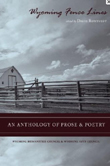Wyoming Fence Lines
Reviews | Purchase
Across Wyoming stretch miles of fence lines of wood and wire, brick and stone. Fences frame our homes, ranches roadsides, schoolyards, and cemeteries. They even frame our churches and the land we have marked as wilderness. And then there are other fences - fences of religion, of national identity, of gender and sexuality, of ethnicity and race. The fifty-seven writers from Wyoming and beyond whose poems, stories, and essays appear in Wyoming Fence Lines consider fences in both their visible and invisible forms. In his introduction to this collection, editor David Romtvedt writes, "It is clear that the fence represents something important in our psyches. And clear, too, that like most things that have a psychological dimension, the fence reveals the diversity of our experience and of our response to experience." In these pages, the fence sometimes inspires ambivalence. Fences isolate, yet they also bring us together. They separate us from outsiders while creating a space where strangers can meet and talk. What is it we need to fence in, or fence out? Wyoming Fences Lines invites readers to explore this question and, in the words of the editor, to "build fences only when you think they're needed, and only where you want them to stand."
Selections from Wyoming Fence Lines
